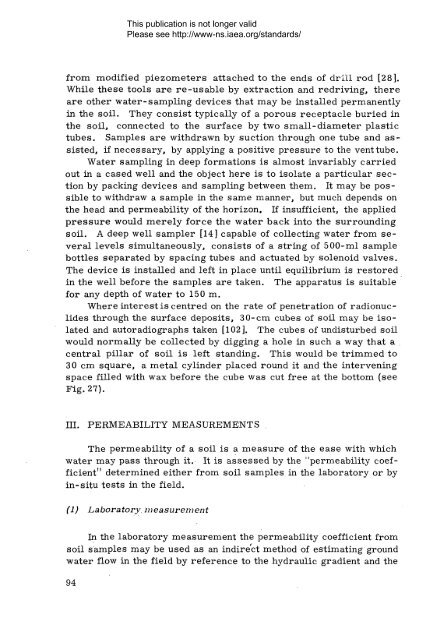Safety_Series_015_1965 - gnssn - International Atomic Energy ...
Safety_Series_015_1965 - gnssn - International Atomic Energy ...
Safety_Series_015_1965 - gnssn - International Atomic Energy ...
You also want an ePaper? Increase the reach of your titles
YUMPU automatically turns print PDFs into web optimized ePapers that Google loves.
This publication is not longer validPlease see http://www-ns.iaea.org/standards/from modified piezometers attached to the ends of drill rod [28].While these tools are re-usable by extraction and redriving, thereare other water-sampling devices that may be installed permanentlyin the soil. They consist typically of a porous receptacle buried inthe soil, connected to the surface by two small-diameter plastictubes. Samples are withdrawn by suction through one tube and assisted,if necessary, by applying a positive pressure to the vent tube.Water sampling in deep formations is almost invariably carriedout in a cased well and the object here is to isolate a particular sectionby packing devices and sampling between them. It may be possibleto withdraw a sample in the same manner, but much depends onthe head and permeability of the horizon. If insufficient, the appliedpressure would merely force the water back into the surroundingsoil. A deep well sampler [14] capable of collecting water from severallevels simultaneously, consists of a string of 500-ml samplebottles separated by spacing tubes and actuated by solenoid valves.The device is installed and left in place until equilibrium is restoredin the well before the samples are taken. The apparatus is suitablefor any depth of water to 150 m.Where interest is centred on the rate of penetration of radionuclidesthrough the surface deposits, 30-cm cubes of soil may be isolatedand autoradiographs taken [102]. The cubes of undisturbed soilwould normally be collected by digging a hole in such a way that acentral pillar of soil is left standing. This would be trimmed to30 cm square, a metal cylinder placed round it and the interveningspace filled with wax before the cube was cut free at the bottom (seeFig. 27).III. PERMEABILITY MEASUREMENTSThe permeability of a soil is a measure of the ease with whichwater may pass through it. It is assessed by the "permeability coefficient"determined either from soil samples in the laboratory or byin-situ tests in the field.(1) Laboratory, measurementIn the laboratory measurement the permeability coefficient fromsoil samples may be used as an indirect method of estimating groundwater flow in the field by reference to the hydraulic gradient and the94
















